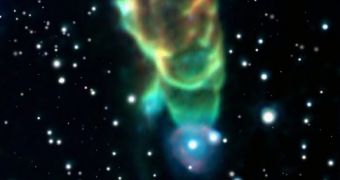The newly discovered pre-main sequence young star HH211, located in the Perseus constellation at a distance of about 1,000 light years from Earth, represents the first solid evidence that stars dispose of angular momentum not only by emitting large gas jets from its poles and shedding part of its upper layers, but also by ejecting gas in a backwards spinning spiral moving away from the cosmic object.
As we all know, stars form in large clouds of dust and gas which start spinning and collapse into dense objects under the influence of gravity, that will eventually accrete the remnant material into flat disks spinning around them. The angular momentum of a star, which represents the tendency of a given object to keep on spinning, originates in the early stages of the star formation, as the cloud of gas starts spinning. However, in order to draw in more material so that the star can grow, a part of this angular energy must be eliminated as gas before it collapses towards the star.
A part of the molecular hydrogen gas drawn closer by the star's gravity is ejected in the form of gas jets originating in the star's poles, perpendicularly to the accretion disk, in bipolar jets, thus gas spinning around the axis of the ejected material would carry part of the excess angular momentum away from the star.
The 20,000 year old star has a current mass of approximately six percent of that of our Sun, and, taking into consideration the material spinning around it, it will probably grow into a Sun-like star. The gas jets ejected from its poles move outwards into interstellar space at supersonic speeds. Furthermore, the angular momentum it carries as it moves away from the star at speeds exceeding 320,000 kilometer per hour determines the jets to spin at speeds of more than 4,800 kilometers per hour.
Future observations of HH 211 and similar protostar-jet systems might provide us with more detailed measurements. However, past experiences showed that these observations are rather difficult, taking into consideration the fact that narrow jets are needed to detect the actual signs of rotation and the limited resolution of the instruments used to make such observations.
In order to solve the problem with the Submillimeter Array's 8-elements interferometer, located on Mauna Kea and used to make the measurements of HH 211, with limited resolution, a construction began at the Atacama Large Millimeter/Submillimeter Array to get a better view of the places in which these young stars are born.

 14 DAY TRIAL //
14 DAY TRIAL //